
 |
||||
| INDEX |
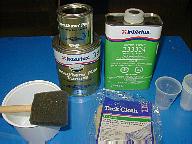 This polyurethane seems to be a pretty obscure item. Many marine stores do not carry it. I got it from Defender which doesn't even list it in their huge catalogue. Make sure to ask for the 'clear' type since this line contains mostly pigmented coatings. |
Interthane Plus (a two
part polyurethane, which has been renamed to "Perfection Varnish")
is another top notch product which will protect the epoxy from UV damage
and give your kayak the ultimate gloss and a scratch resistant coat. Unlike
many varnishes, it is completely clear (it has no hue or tint). It is
also substantially more expensive ~ $50/ quart or liter. Add the 'must
have' solvent and it comes to $60+. |
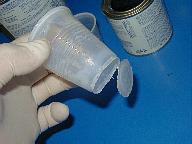 |
I
use the small 4oz. disposable cups to dispense the measured quantities.
You got about 2 minute window to measure off the amounts and pour it into
a polyethylene or some other mixing container. If you wait longer the styrene
cups disintegrate right in front of your eyes. I dispense the larger portion
of the resin first, then reuse the cup to measure off the hardener with
the solvent together. The solvent thins the dense hardener which can be
then poured out with little waste. Mixing: Interthane Plus is mixed in 3:1 ratio by volume (3 parts resin, 1 part hardener). I thin it further by adding 1 part of the 2333N reducer to achieve 'my ideal' viscosity for foam brush application. Make sure to use the 2333N ONLY!! Other solvents will not work. The oil based Interlux varnish brushing liquid 333 will definitely not work. The entire package was sufficient to give the kayak 4 coats total (4 hull and 4 deck) with little leftover. |
  |
Interthane
Plus contains some very potent solvents. I always pour a test sample on
my 'chemically inert' plastic table but in this case, the poly has fused
in irreversibly and softened the plastic to a considerable depth (whereas
varnish or epoxy would just set and peel off). The hardened Poly film is
very strong and is similar to cellophane (clear hard candy wrappers). By
contrast, varnish never really hardens but always remains soft and ductile
(stretchable). NOTE: Interthane Plus must be applied in thin coats not only to prevent drips but because the solvent must evaporate to a large degree from the mix so that the two components can properly react and harden. The timing seems to be all important. If you apply a thick coat (like the bar top epoxy) or leave it in the container, the poly will gel, turn opaque but will not harden - ever. This is consistent with the behavior of thinned epoxy. The reducer simply interferes with the chemical reaction and if the polymerization is not completed in a set time the coat is ruined. The white puck (leftover gelled batch) is a good example of this. Also, the solvent which was completely blended in actually exuded (sweated out) out of the mass. |
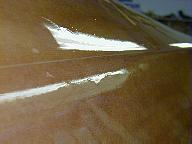 |
The brush application is no different from varnish. Interthane will also sag and drip when brushed on too thickly but the 'window of opportunity' which allows you to blend or feather older and new coats together is slightly longer than for varnish. One great advantage is that Interthane can be recoated without prior sanding. This is particularly useful on the first coats. Recoating without sanding of course leaves the old dust on the previous layer. It has has to be eventually sanded off prior to the finish coats. The sag peaks will be highlighted with a magic marker (see previous page) and knocked down with wet sandpaper (220 or 180 grit). |
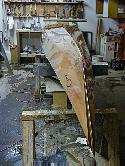 S&G Cirrus |
You
will hardly get a better gloss with anything else. Interthane Plus Pros':
Interthane Plus Cons':
|
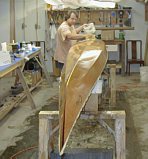 |
Protective plastic "roof" is very helpful if wood dust keeps raining from overhead light fixtures or rafters. |
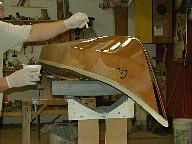 |
Four feet into polyurethaning. |
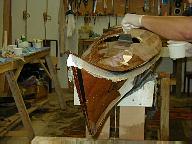 |
One half of the deck is done, the other half is feathered in on the deck center line seam. |
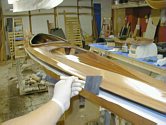 |
|
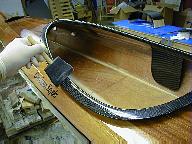 |
The
coaming can be done first or last. Here, I am doing it last. |
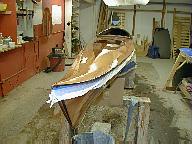 |
Just
finished the rear deck on the plywood
Cirrus. The brush marks are still visible in the reflection. The pot
life on the Interthane is quoted as 8 hours so the coat has enough time
to level out. Only 3" masking tape is used to mask off the already
finished hull. |
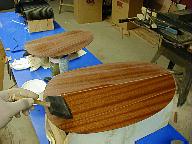 |
The hatches can be varnished at any time. I use whatever is left over in the cup after doing the kayak and coat the small items like rudder, hatches, bulkheads, composite handles and hardware, backrest......... |
| INDEX |
| Home | Kayak Designs | Kayak Shop | Materials | Kayak Gallery | About us |
| Building Manual | Plans | Sandwich Core | Wood Kayak | Order | |
| Epoxy Test | Abrasion Cloth | Rudder | Resources | Choosing Kayak | Guestbook |
If you notice any problems with the site (i.e. error links, missing images) please, let me know. Thanks
Mail:
Vaclav Stejskal
10 Colonial Court apt. 73
Stoneham, MA. 02180
USA
Tel: 781-481-9261
© 1999
- 2020 Copyright Vaclav Stejskal
All rights reserved
Last page update:
11 January 2020